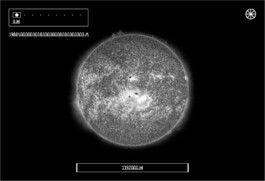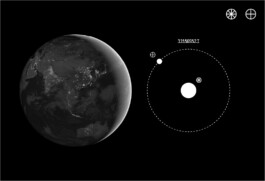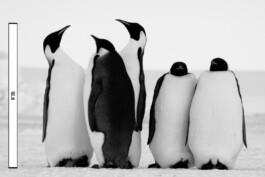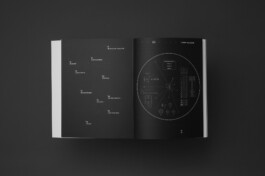Humans are a species of explorers, who for centuries have gazed upon the stars and asked themselves whether there is some distant neighbor out there. This is our proposal for an interstellar message.

“Look again at that dot. That’s here. That’s home. That’s us. On it everyone you love, everyone you know, everyone you ever heard of, every human being who ever was, lived out their lives.”
Carl Sagan

Schematics
96 × 72 cm

Our work consists of three etched silicon disks that encompass the topics science, earth and humanity. With more than 500 images we create a common vocabulary, present the planet that we live on and which beings it is populated with, and we describe the human species from its anatomy to its habitat and the way it shapes and changes its environment.
As the medium for our message we chose a silicon wafer such as the ones used for microchips. Using a photolithographic process, these less than a millimeter thin disks can be provided with ultra-fine nanometer-scale structures. This makes it possible to produce images directly in the medium as a relief, with a structural resolution of approximately 50,000 dpi.
1st Disk
Science

This first disk is the foundation for understanding the contents of the second and third disk. It provides basic information about our planetary system and our understanding of science.


In order to establish a decimal numeric system, mathematical operators and scientific units, we developed a limited special-purpose character set.
When using digits it is paramount that the glyphs can be distinguished from one another clearly, since the misinterpretation of even a single digit could gravely alter the meaning of a piece of information. The glyphs we developed differ from each other more distinctly than conventional ones and are also not rotation-dependent.

This graphic is, in a way, the centerpiece of the first disk and shows the by far most abstract and (for non-scientists) most difficult concept to understand.
Using this so called hyperfine structure transition of the hydrogen atom — a process that seems abstract but can be universally observed in stars — we can introduce scientific units for length, time and mass.
2nd Disk
Earth

The second disk contains more in-depth information about earth, its geography including different biomes and the lifeforms that populate it.
It shows where humans can be found in the greater context of all life and displays a modern scientific understanding of ourselves, that assumes humanity to be part of nature and not its superior.
Thus the complete lower half of the disk is filled with a representative tree of life, showing 254 different species from different branches and their genetic relationship to each other.


The decision which species to show in this tree of life was made through a number of differently weighted criteria. The primary goal was to show a broad spectrum and to display a representative number of lifeforms from every branch.
The species are roughly split into the categories Bacteria, Archaea and Eukaryota, which in turn is split into animals, plants and fungi.
3rd Disk
Humankind

The third disk concerns humankind. It shows human anatomy, different phenotypes, behavioral patterns and technological achievements. As a model for this part we chose objective scientific descriptions such as the ones you would find in an encyclopedia.
In comparison to other interstellar messages we also include negative aspects of our life (such as environmental destruction or war), to make sure it’s an accurate and therefore honest portrait of our species.
The main purpose of this message is to show a foreign intelligence who and where we are. But it’s also a snapshot of the present that shows that we have only this one planet to call home and that we carry the responsibility for our future.

3rd Disk

Image sequence showing the environmental changes caused by humans

By using a strict structure for each photographic image, we make it easier to recognize particular elements, while at the same time showing that they are part of the image but not of object shown.
All images use a scale showing the size of the object. In the upper right corner there are reference symbols with which particular images can be linked to one another.

The “reference symbols” allow the description of even somewhat complex matters by allowing us to create links — and thus relationships — between different images.
Through this system we can create connections between the three disks — something which would otherwise have only been possible through spacial proximity. That way we can for instance create connections between bacteria (2nd disk) and diseases (3rd disk), explicitly explain the function of our sensory organs or establish the fact that fish live in water.
Reference symbols
Connections between the disks


We created a book to accompany the disks and to explain the process of their conception. It is a compact but extensive reader that introduces our project and explains the concept and the design of the disks.
This book is important, because, while the disks alone do provide ample information about humanity, they alone do not deliver insight into our creative process.
While the message is written in such a way that it can be understood universally, without knowledge of human writing, speech or culture, especially the first disk requires deep scientific knowledge.
Thus our book also serves to explain our concept of “semiotics for aliens,” which is indispensable for an interstellar message.
Bachelor’s thesis
in collaboration with Yannic Sturm, 2016

Humans are a species of explorers, who for centuries have gazed upon the stars and asked themselves whether there is some distant neighbor out there.
This is our proposal for an interstellar message.
“Look again at that dot. That’s here. That’s home. That’s us. On it everyone you love, everyone you know, everyone you ever heard of, every human being who ever was, lived out their lives.”
Carl Sagan

Our work consists of three etched silicon disks that encompass the topics science, earth and humanity. With more than 500 images we create a common vocabulary, present the planet that we live on and which beings it is populated with, and we describe the human species from its anatomy to its habitat and the way it shapes and changes its environment.
As the medium for our message we chose a silicon wafer such as the ones used for microchips. Using a photolithographic process, these less than a millimeter thin disks can be provided with ultra-fine nanometer-scale structures. This makes it possible to produce images directly in the medium as a relief, with a structural resolution of approximately 50,000 dpi.

Schematics
1st Disk
Science

This first disk is the foundation for understanding the contents of the second and third disk. It provides basic information about our planetary system and our understanding of science.

Detail of the 1st disk

In order to establish a decimal numeric system, mathematical operators and scientific units, we developed a limited special-purpose character set.
When using digits it is paramount that the glyphs can be distinguished from one another clearly, since the misinterpretation of even a single digit could gravely alter the meaning of a piece of information. The glyphs we developed differ from each other more distinctly than conventional ones and are also not rotation-dependent.

This graphic is, in a way, the centerpiece of the first disk and shows the by far most abstract and (for non-scientists) most difficult concept to understand.
Using this so called hyperfine structure transition of the hydrogen atom — a process that seems abstract but can be universally observed in stars — we can introduce scientific units for length, time and mass.
2nd Disk
Earth

The second disk contains more in-depth information about earth, its geography including different biomes and the lifeforms that populate it.
It shows where humans can be found in the greater context of all life and displays a modern scientific understanding of ourselves, that assumes humanity to be part of nature and not its superior.
Thus the complete lower half of the disk is filled with a representative tree of life, showing 254 different species from different branches and their genetic relationship to each other.

Detail of the 2nd disk

The decision which species to show in this tree of life was made through a number of differently weighted criteria. The primary goal was to show a broad spectrum and to display a representative number of lifeforms from every branch.
The species are roughly split into the categories Bacteria, Archaea and Eukaryota, which in turn is split into animals, plants and fungi.
3rd Disk
Humankind

The third disk concerns humankind. It shows human anatomy, different phenotypes, behavioral patterns and technological achievements. As a model for this part we chose objective scientific descriptions such as the ones you would find in an encyclopedia.
In comparison to other interstellar messages we also include negative aspects of our life (such as environmental destruction or war), to make sure it’s an accurate and therefore honest portrait of our species.
The main purpose of this message is to show a foreign intelligence who and where we are. But it’s also a snapshot of the present that shows that we have only this one planet to call home and that we carry the responsibility for our future.

Detail of the 3rd disk

Image sequence showing the environmental changes caused by humans

By using a strict structure for each photographic image, we make it easier to recognize particular elements, while at the same time showing that they are part of the image but not of object shown.
All images use a scale showing the size of the object. In the upper right corner there are reference symbols with which particular images can be linked to one another.

An important element of our concept are so called “reference symbols.” They allow the description of even somewhat complex matters by allowing us to create links – and thus relationships – between different images.
Through this system we can create connections between the three disks – something which would otherwise have only been possible through spacial proximity. That way we can for instance create connections between bacteria (2nd disk) and diseases (3rd disk), explicitly explain the function of our sensory organs or establish the fact that fish live in water.

Reference symbols

We created a book to accompany the disks and to explain the process of their conception. It is a compact but extensive reader that introduces our project and explains the concept and the design of the disks.
This book is important, because, while the disks alone do provide ample information about humanity, they alone do not deliver insight into our creative process.
While the message is written in such a way that it can be understood universally, without knowledge of human writing, speech or culture, especially the first disk requires deep scientific knowledge.
Thus our book also serves to explain our concept of “semiotics for aliens,” which is indispensable for an interstellar message.
Bachelor’s thesis
with Yannic Sturm,
2016




























